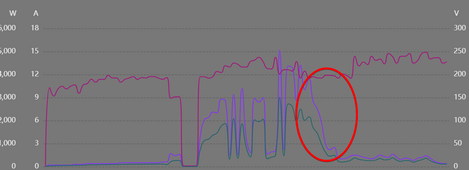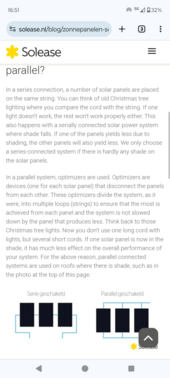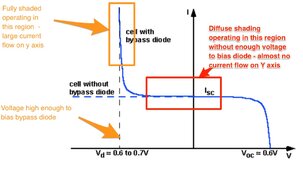axum
New Member
I bought 12 Hyperion 400W bifacial panels recently and have 8 of them currently hooked up in series and connected to a Sol-Ark 15K (MPPT 1)
The location of the install (ground mount) is not ideal as one panel gets partly shaded after around 2PM. I know I could move the panel to another location but that's not really the point of my question.
So I'm getting 3000+ watts when all panels get direct sunshine (which is pretty good, given that the orientation isn't perfect). However, once ONE panel gets shaded, the output immediately drops to 450 watts or less, even though the other 7 panels are still fully lit by the sun. I always thought that bypass diodes in the panels would prevent such a thing.
Does this particular panel not have bypass diodes? If it does, why is this happening?
Here's the chart of the power output:

Disregard the numbers for power output on the left. Must be a bug in the My-Solark website because the actual power was 3000W at the peak. Also ignore everything to the left of the 3000W peak around the middle of the graph.
The purple line is the power output of the panel, it drops to 450W when one panel gets shaded. The red line is the voltage, green line is current.
The red circle indicates when one panel got shaded (started by a little shade and within an hour it was fully shaded)
The location of the install (ground mount) is not ideal as one panel gets partly shaded after around 2PM. I know I could move the panel to another location but that's not really the point of my question.
So I'm getting 3000+ watts when all panels get direct sunshine (which is pretty good, given that the orientation isn't perfect). However, once ONE panel gets shaded, the output immediately drops to 450 watts or less, even though the other 7 panels are still fully lit by the sun. I always thought that bypass diodes in the panels would prevent such a thing.
Does this particular panel not have bypass diodes? If it does, why is this happening?
Here's the chart of the power output:

Disregard the numbers for power output on the left. Must be a bug in the My-Solark website because the actual power was 3000W at the peak. Also ignore everything to the left of the 3000W peak around the middle of the graph.
The purple line is the power output of the panel, it drops to 450W when one panel gets shaded. The red line is the voltage, green line is current.
The red circle indicates when one panel got shaded (started by a little shade and within an hour it was fully shaded)




